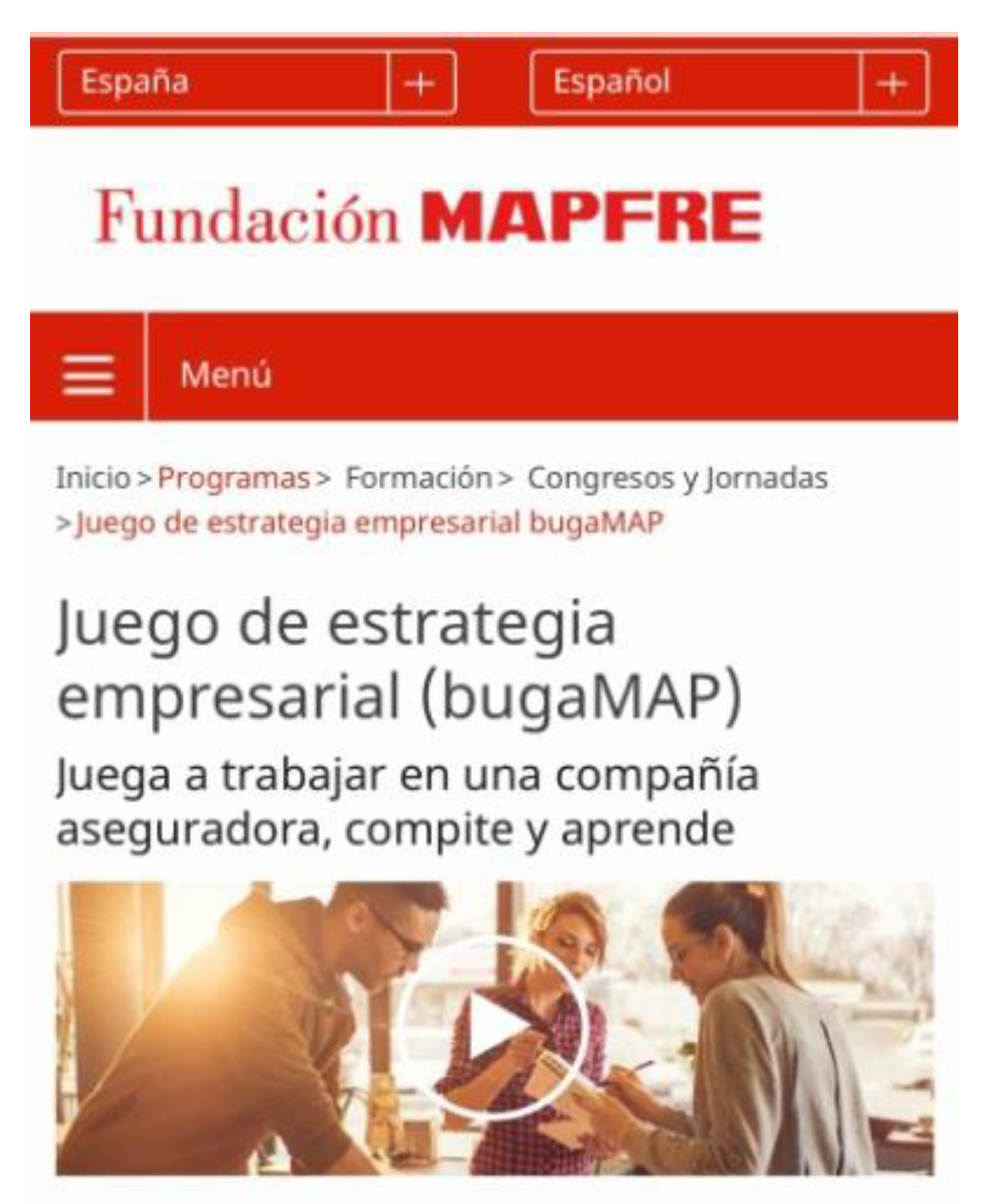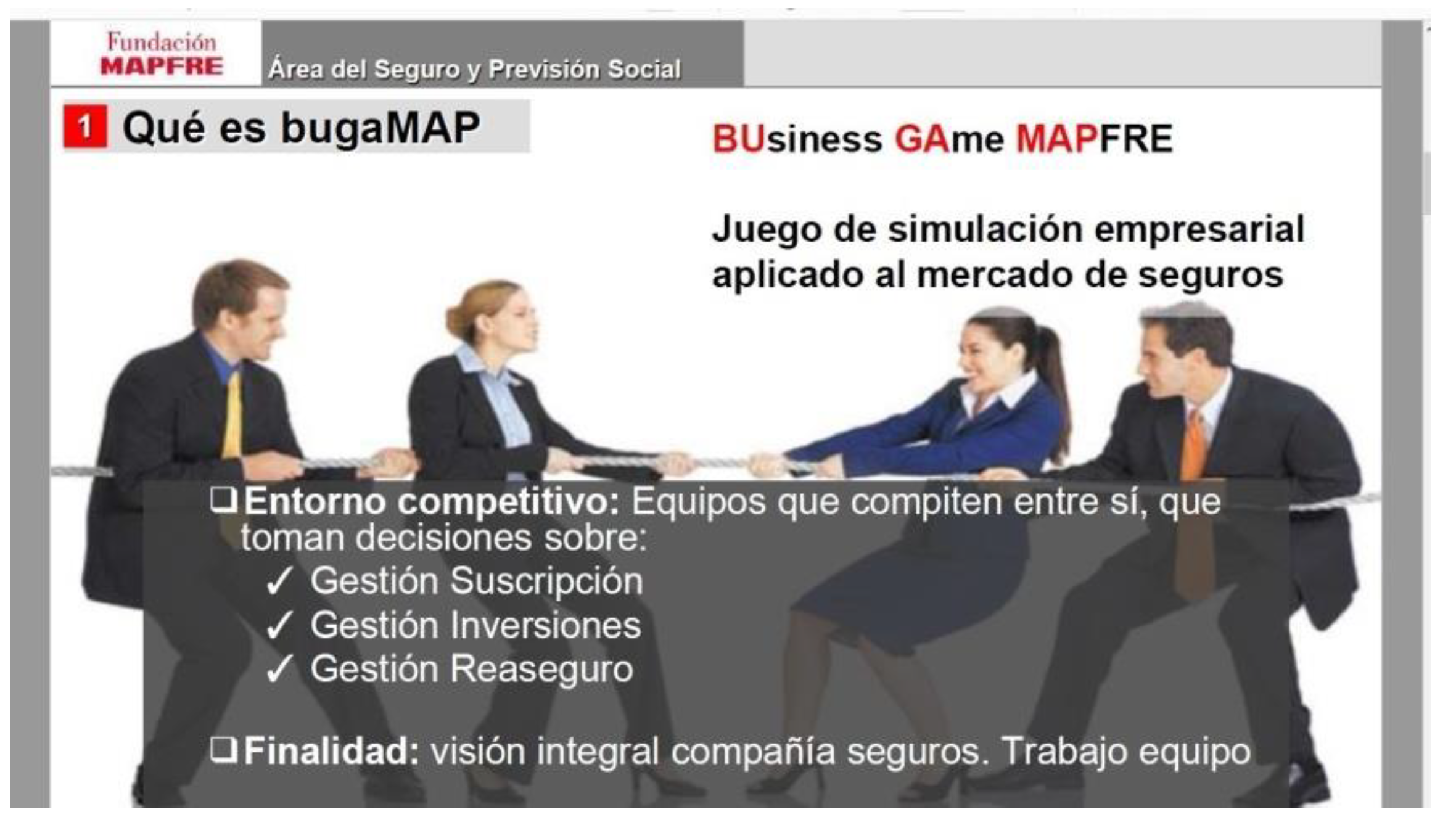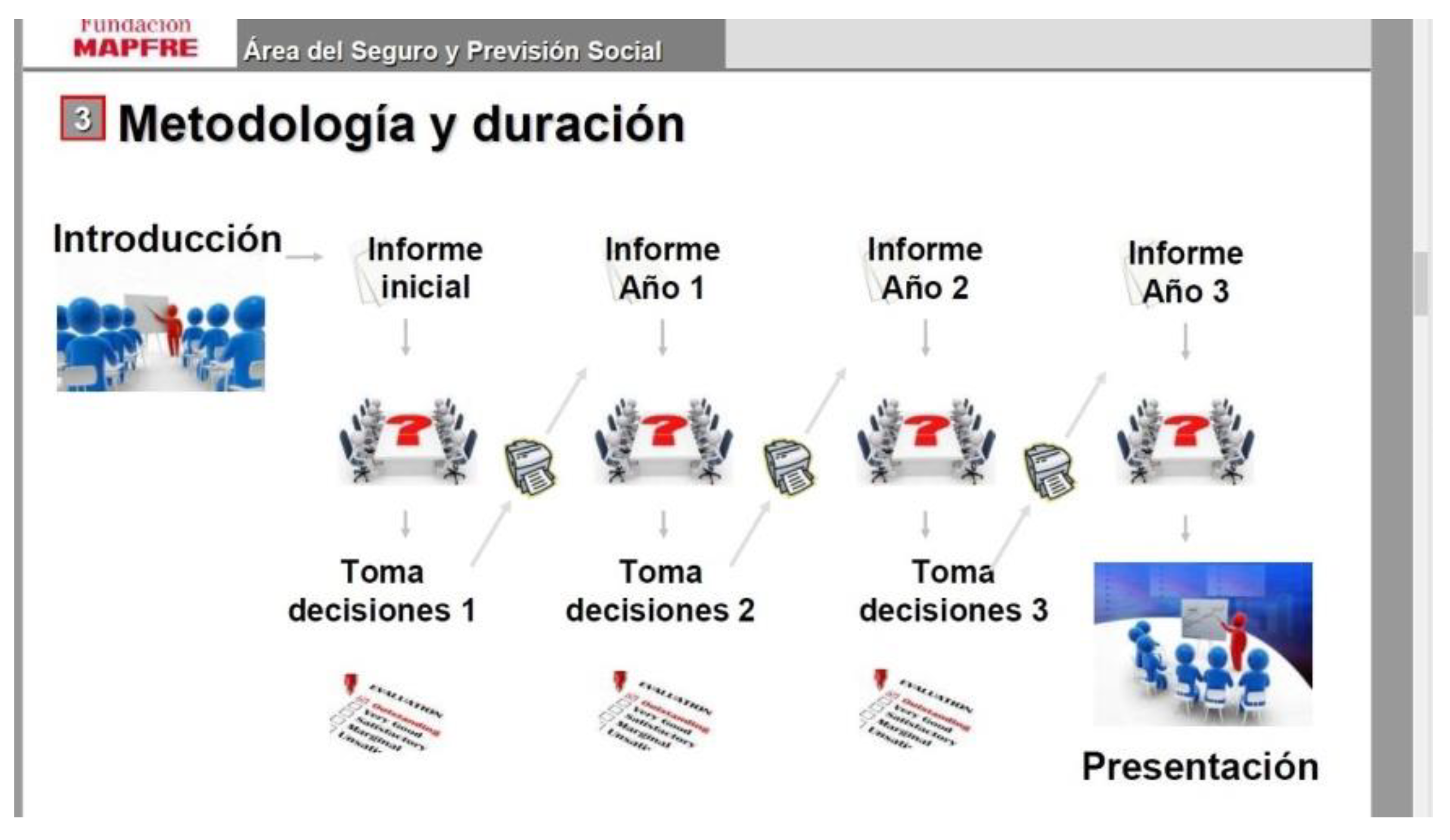Company–University Collaboration in Applying Gamification to Learning about Insurance
Abstract
:1. Introduction
1.1. The Production of Serious Video Games in the Video Game Industry
“As we look towards the future, we foresee games playing an increasingly impactful role in disrupting and reshaping traditional industries, from implementing individual game mechanics to an array of mergers and acquisitions crossing the boundaries of traditional industries.”([3], p. 5)
1.2. Gamification as a Unique Way to Engage in Learning
1.3. Gifts for Effort and Motivating through Gamification
- -
- Competence—that the person can be effective in the tasks performed. According to Frasca (2012) [21], gamification has the effect of activating the desire to improve personal performance in a task. A final “try again” message for example, makes it possible for the user to make mistakes without dramatic consequences. According to Ryan and Deci’s research on education, if the student feels efficacious, he/she will more easily adopt a goal as their own, thus in order to facilitate internalization of a goal they recommend offering “optimal challenges and effectance-relevant feedback” ([19], p. 64).
- -
- Relation—that the person can interact and be involved. To describe this aspect, Smethurst (2015) [22] suggests using “interreacting with the game” as the most appropriate term to emphasize that it consists of an innovation that goes beyond simply “interacting” which was already possible with more traditional media such as television or radio. In their self determination theory about motivation in school (SDT), Ryan and Deci name this aspect “sense of relatedness” meaning “sense of belongingness and connectedness to the persons, group, or culture” which is obtained by being valued by significant others to whom one feels connected.
- -
- And, autonomy—that the person can feel in control of his/her own life. That is, the user makes decisions and discovers his/her own way (more on the aspect of decisions below). According to research done by various authors reviewed by Ryan and Deci ([19], p. 63) autonomy and self-regulation contexts facilitate internalization of goal and behavioral regulations at schools. By the contrary, when students were more externally regulated, they showed a tendency to blame others for negative outcomes while more autonomy correlated with interest and enjoyment ([19], p. 63).
1.4. Other Aspects in Gamification: Decisions and Narrative
1.5. Trends towards Gamification in University Education to Train Generic and Transversal Skills
- The ability to control attention: thoughts and feelings (skills 1 and 2 in Table 2);
- The power to convert others into potential allies and to be able to strengthen the relationships that we already have (skill 10 in Table 2);
- Natural ability to motivate and overload heroic qualities (willpower, compassion, and determination) (skills 4, 5, 7, 8, and 9 in Table 2).
2. Materials and Methodology
2.1. Methodological Aspects of the Subjective Evaluation
2.2. Variables and Indicators for Objective Evaluation
- Narrative and decision making—This variable is about discerning the experiences for problem solving that the game designs (Gee 1). Each game has a story that enlivens the game, a story that makes the game interesting and motivating in itself. Describing the narrative consists of reconstructing the story, the real story that is simulated in the game, and determining in what territory or place it is framed, who are the characters, what is the role of the player or team of players, what is the objective of the game, and what resources are available to reach the objectives. This part trains skills such as “make your own decisions and take the consequences” (Cervera 8) and "be yourself and live your own experience” (Cervera 7).
- Levels of experience that measure progress—This variable is a very relevant part of the gamification process and consists of the game being able to create flow starting with manageable challenge and low stress (Gee 8); allow for early success and the margin to accommodate larger challenges (Gee 7); lower the cost of failure to encourage exploration and innovation (Gee 19). It is part of the motivation aspect, that the player looks competent because he/she is addressing achievable tasks. This part of the gamification would train for the ability to “take risks, dare to risks” (Cervera4) and to “compete in face of achievable challenges” (Cervera 5).
- Multiples short term and long-term objectives—This variable addresses how the game manages the economy of attention (Gee 2); if the game does a good job of combining the mechanics with the contents (Gee 4); if the game starts with simpler mechanics at the beginning and then goes deeper (Gee 6); and if the game orders the problems well, so as to generate ideas (Gee 10). This part of the gamification trains the ability to “have purposes to accomplish objectives” (Cervera 1) and the ability to “think long term” (Cervera 2).
- Gifts the efforts—This variable addresses analyzing which behaviors are most valued by the game, in which direction the person is motivated, and what awards/rewards are given in the sense that the game relies on learning by doing (Gee 11). These data indicate if the game transmits motivation, involvement, persistence, identity (Gee 3) and that the mechanics of the game have a “fair” functioning (Gee 5).
- Respond quickly frequently and clearly—This variable addresses the game’s ability to provide data useful for solving problems (Gee 12); to give a lot of feedback useful for progress (Gee 17); to provide data that advise growth and trajectory (Gee 21); provide data to assure learning is integrative and that there is evaluation (Gee 22). The skill related to this part of the gamification would be to “ask all the possible questions” (Cervera 6).
- Element of final uncertainty (epic moments)—This variable addresses whether the game manages to create the expert cycle, practice-domain-challenge (Gee 9); if the activities connect with achievements and strategies (Gee 13); if systemic thinking is encouraged (Gee 24). By systemic thinking it is understood that the game allows the player to see the whole picture and not just individual actions, which helps the player see how the pieces fit together or can fit together.
- Windows of information to assist with decision making and learning from decision impacts—This variable addresses whether the game places meaning of words with actions (Gee 14); if it gives language and information just at the right moment (Gee 15); if the game creates “fish tanks” and “sandboxes” to reflect on (Gee 16). As seen in the framing theory, information given at the right time is assimilated better.
- Other people–collective game or comparing and commenting with others—This is a variable that can be measured in terms of individual play or team play, if there is a pooling, whether the decisions are individual or in teams. And, according to Gee 18 and Gee 20, it also measures whether the teachers give feedback to the game designers, and if the game offers options and opportunities of customization. This part of gamification addresses training related to the ability to collaborate with others in multiplayer games and the ability to learn to play together (Cervera 10).
3. Results
3.1. Results of the Subjective Evaluation by Questionnaire to Players
3.2. Results of the Objective Evaluation of the Gambling Experience
3.2.1. Narrative and Decision Making
3.2.2. Levels of Experience that Measure Progress
3.2.3. Multiple Short-Term and Long-Term Objectives
3.2.4. Gifts for Efforts
3.2.5. Respond Quickly, Frequently, and Clearly
3.2.6. Element of Final Uncertainty (Epic Moments)
3.2.7. Featured Attention Windows. Information Contributions
3.2.8. Other People–Collective Gamers or Comparing and Commenting with Others
4. Discussion
Author Contributions
Funding
Acknowledgments
Conflicts of Interest
Appendix A. 24 Principles of Video Game Design for Learning (Gee 2016, UNESCO)
References
- Hamari, J.; Koivisto, J.; Sarsa, H. Does gamification work? A literature review of empirical studies on gamification. In Proceedings of the 47th Hawaii International conference on System Science, Hilton Waikoloa, HI, USA, 6–9 January 2014; IEEE Computer Society: Washington, DC, USA, 2014. [Google Scholar] [CrossRef]
- Nah, F.; Telaprolu, V.; Rallapalli, S.; Venkata, P. Gamification of Education using Computer Games. In HCI 2013, Part III. LNCS; Yamamoto, S., Ed.; Springer: Berlin/Heidelberg, Germany, 2013; Volume 8018, pp. 99–107. [Google Scholar]
- Newzoo Consultancy. Global Games Report 2018; Short Free Version; Newzoo Europe: Amsterdam, The Netherlands, 2019. [Google Scholar]
- Deterding, S.; Dixon, D.; Khaled, R.; Nacke, L. From game design elements to gamefulness: Defining gamification. In Proceedings of the 15th International Academic MindTrek Conference: Envisioning Future Media Environments, Tampere, Finland, 6–8 October 2010; ACM: New York, NY, USA, 2011; pp. 9–15. [Google Scholar]
- Hamari, J. Do badges increase user activity? A field experiment on the effects of gamification. Comput. Hum. Behav. 2017, 71, 469–478. [Google Scholar] [CrossRef]
- Dicheva, D.; Dichev, C.; Agre, G.; Agelova, G. Gamification in Education. A systematic Mapping Study. Educ. Technol. Soc. 2015, 18, 75–86. [Google Scholar]
- Desarrollo Español de Videojuegos. Libro Blanco del Desarrollo Español de Videojuegos 2017; Desarrollo Español de Videojuegos (DEV): Madrid, Spain, 2018. [Google Scholar]
- Katsaliaki, K.; Muysafee, N. Edutainement for sustainable development: a survey of games in the field. Simul. Gaming 2015, 46, 647–672. [Google Scholar] [CrossRef]
- Ouariachi, T.; Olvera-Lobo, M.D.; Gutiérrez-Pérez, J. Gaming Climate Change: Assessing Online Climate Change Games Targeting Youth Produced in Spanish. Procedia Soc. Behav. Sci. 2017, 237, 1053–1060. [Google Scholar] [CrossRef]
- Michaud, L.; Alvarez, J.; Alvarez, V.; Djaouti, D. Serious Games: Training & Teaching–Healthcare–Defence & Security–Information & Communication; IDATE: Montpellier, France, 2010. [Google Scholar]
- Markets and Markets. Serious Game Market Worth $5448.82 Million by 2020. Recuperado el 25 de Febrero de 2017, de Markets and Markets. 2015. Available online: http://www.marketsandmarkets.com/PressReleases/serious-game.asp (accessed on 8 September 2019).
- Rojo, T.; Dudu, S. Los videojuegos en la implementación de políticas de mitigación del cambio climático. Ambitos Revista Internacional de Comunicación 2017, 37, 1–25. [Google Scholar]
- Chatfield, T. Fun INC: Why Games Are the 21st Century’s More Serious Business; Virgin Publishing Ltd.: London, UK, 2010. [Google Scholar]
- Grimaud, E. Beau-Bien-Bon: La Formule Magique Pour Sourire à la vie! Marabout: Marabout, France, 2017. [Google Scholar]
- After Watching this Your Brain will not be the Same. Available online: https://www.youtube.com/watch?v=LNHBMFCzznE (accessed on 18 September 2019).
- Rojo, T.; Dudu, S. Los “juegos serios” como instrumento de empoderamiento y aprendizaje socio-laboral inclusivo. Revista Fuentes 2017, 19, 95–109. [Google Scholar] [CrossRef]
- Lakoff, G. Don’t Think of An Elephant. Know Your Values and Frame the Debate; Chelsea Green Publishing: White River Junction, VT, USA, 2004. [Google Scholar]
- Kapp, K.M.; Blair, L.; Mesch, R. The Gamification of Learning and Instruction Fieldbook Ideas into Practice; Wiley: San Francisco, CA, USA, 2014. [Google Scholar]
- Ryan, R.M.; Deci, E.L. Intrinsic and Extrinsic Motivations: Classic Definitions and New Directions. Contemp. Educ. Psychol. 2000, 25, 54–67. [Google Scholar] [CrossRef] [PubMed]
- Werbach, K.; Hunter, D. How Game Thinking Can Revolutionize Your Business; Wharton Digital Press: Philadelphia, PA, USA, 2012. [Google Scholar]
- Frasca, G. Los Videojuegos Enseñan Mejor que la Escuela. Tedxtalks Junio de 2012 Monteviedo. 2012. Available online: https://www.youtube.com/watch?v=TbTm1Lkm18o&t=11s (accessed on 8 September 2019).
- Smethurst, T.; Craps, S. Playing with Traume: Interreactivity, Empathy and Complicity with the Walking Dead Video Game. Game Cult. 2015, 10, 269–290. [Google Scholar] [CrossRef]
- Nah, F.-H.; Zeng, Q.; Telaprolu, V.R.; Ayyappa, A.P.; Eschenbrenner, B. Gamification of Education: A Review of Literature. In HCI in Business; LNCS, Nah, F.-H., Eds.; Springer: Berlin/Heidelberg, Germany, 2014; pp. 401–409. [Google Scholar]
- Cervera, H. Diez Cosas que Aprendí de los Videojuegos. Enero de 2012 [Vídeo de Youtube] Recuperado de. 2012. Available online: https://www.youtube.com/watch?v=Q4nFUFO_rXw (accessed on 8 September 2019).
- Design Principles for Video Games as Learning Engines. Available online: http://mgiep.unesco.org/wpcontent/uploads/2016/02/3-webinar-reading-reference.pdf (accessed on 8 September 2019).
- Contreras, R.; Eguia, J. (Eds.) Gamificación en las aulas universitarias; (Bellaterra). Barcelona: Universidad Autónoma de Barcelona. Recuperado a partir de. 2016. Available online: http://incom.uab.cat/download/eBook_incomuab_gamificacion.pdf (accessed on 8 September 2019).
- McGonigal, J. SuperBetter: A Revolutionary Approach to Getting Stronger, Happier, Braver and More Resilient—Powered by the Science of Games; Penguin: New York, NY, USA, 2015. [Google Scholar]
- González-Limón, M.; Serrano-García, A. Innovación en las Enseñanzas Universitarias Para el Aprendizaje del Sector Empresarial Asegurador: Una Experiencia con BugaMAP en la Universidad de Sevilla. In Innovación en la Práctica Educative; Egregius Ediciones: Sevilla, Spain, 2018; pp. 212–226. [Google Scholar]
- Fundación Mapfre Website. Available online: https://www.fundacionmapfre.org/fundacion/es_es/programas/formacion/congresos-jornadas/juego-estrategia-seguros-bugamap.jsp (accessed on 8 September 2019).
- Cronbach, L.J.; Shavelson, R.J. My current thoughts on coefficient alpha and successor procedures. Educ. Psychol. Meas. 2004, 64, 391–418. [Google Scholar] [CrossRef]
- Encuesta BugaMAP 2018 de opinión y actitudes de los estudiantes de la Universidad de Sevilla sobre BugaMAP. 2018. Available online: https://docs.google.com/forms/d/1EPZen9vYYvRRRqMzMQsY-Z-9yPk3lOoAS5uIPYg9co8/viewform?edit_requested=true (accessed on 18 September 2019).



| 1. Levels of experience that measure progress | 2. Multiple short- and long-term objectives |
| 3. Gifts for efforts | 4. Answering in a quick, frequent, and clear way |
| 5. Uncertain final outcome. Increases dopamine | 6. Windows with information, both to help decision making and to learn from decisions impact |
| 7. Other persons (collective game or comparing and comments with others) |
| 1. Have purposes that get results | 2. Think long-term |
| 3. Manage and optimize resources | 4. Take risks, dare to risks |
| 5. Compete in face of achievable challenges | 6. Ask all the possible questions |
| 7. Be yourself or live your own experiences | 8. Make your own decisions and take on the consequences that they have |
| 9. Explore the surroundings | 10. Collaborate with others in multiplayer games, learn to play together. |
| By Degree Studying | Statistics | Mathematics & Statistics | Labor Relations & Human Resources | Tourism | Labor Relations & Finances |
| 142 | 18 | 19 | 74 | 16 | 15 |
| 100% | 13% | 13% | 52% | 11% | 11% |
| By Years | First Year | Second Year | Third Year | Fourth Year | Fifth Year |
| 142 | 16 | 91 | 10 | 22 | 3 |
| 100% | 11% | 64% | 7% | 15% | 2% |
| By Age | 18/19 Years | 20/21 Years | 22/23 Years | Other | |
| 142 | 45 | 54 | 22 | 21 | |
| 100% | 32% | 38% | 15% | 15% | |
| By Gender | Women | Men | |||
| 142 | 98 | 44 | |||
| 100% | 69% | 31% |
| Agree (4–5) | Neuters (3) | Disagree (1–2) | Total | ||
|---|---|---|---|---|---|
| 1 | It is fun | 88% | 10% | 2% | 100% |
| 2 | It is easy to play | 35% | 51% | 14% | 100% |
| 3 | It is well organized | 92% | 6% | 2% | 100% |
| 4 | It is creative | 85% | 13% | 2% | 100% |
| 5 | It is useful for learning | 83% | 13% | 4% | 100% |
| 6 | The concepts and previous instructions are very useful for decision-making | 76% | 18% | 6% | 100% |
| 7 | Facilitates and provides business and insurance sector knowledge | 84% | 12% | 4% | 100% |
| 8 | The duration of the activity has been adequate to acquire the objectives that were proposed at the beginning | 68% | 19% | 13% | 100% |
| 9 | The number of decision-making opportunities is adequate | 80% | 17% | 3% | 100% |
| 10 | The contents developed during the training activity have been useful and have been adapted to my expectations | 71% | 25% | 4% | 100% |
| 11 | It reflects the business reality (insurer) | 83% | 16% | 1% | 100% |
| 12 | The knowledge acquired will be useful in the future | 70% | 23% | 7% | 100% |
| 13 | Value the acquisition of soft skills (management of your work time, leadership and teamwork) | 79% | 19% | 2% | 100% |
| Agree (4–5) | Neuters (3) | Disagree (1–2) | Total | ||
|---|---|---|---|---|---|
| 1 | Overall satisfaction | 85% | 14% | 1% | 100% |
| 2 | The expectations I had regarding the usefulness of the BugaMAP simulation game in which I participated have been met | 80% | 16% | 4% | 100% |
| 3 | In general, I am satisfied with the development of | 83% | 16% | 1% | 100% |
| 4 | I would recommend this training activity to other colleagues | 88% | 9% | 3% | 100% |
© 2019 by the authors. Licensee MDPI, Basel, Switzerland. This article is an open access article distributed under the terms and conditions of the Creative Commons Attribution (CC BY) license (http://creativecommons.org/licenses/by/4.0/).
Share and Cite
Rojo, T.; González-Limón, M.; Rodríguez-Ramos, A. Company–University Collaboration in Applying Gamification to Learning about Insurance. Informatics 2019, 6, 42. https://doi.org/10.3390/informatics6030042
Rojo T, González-Limón M, Rodríguez-Ramos A. Company–University Collaboration in Applying Gamification to Learning about Insurance. Informatics. 2019; 6(3):42. https://doi.org/10.3390/informatics6030042
Chicago/Turabian StyleRojo, Teresa, Myriam González-Limón, and Asunción Rodríguez-Ramos. 2019. "Company–University Collaboration in Applying Gamification to Learning about Insurance" Informatics 6, no. 3: 42. https://doi.org/10.3390/informatics6030042
APA StyleRojo, T., González-Limón, M., & Rodríguez-Ramos, A. (2019). Company–University Collaboration in Applying Gamification to Learning about Insurance. Informatics, 6(3), 42. https://doi.org/10.3390/informatics6030042





